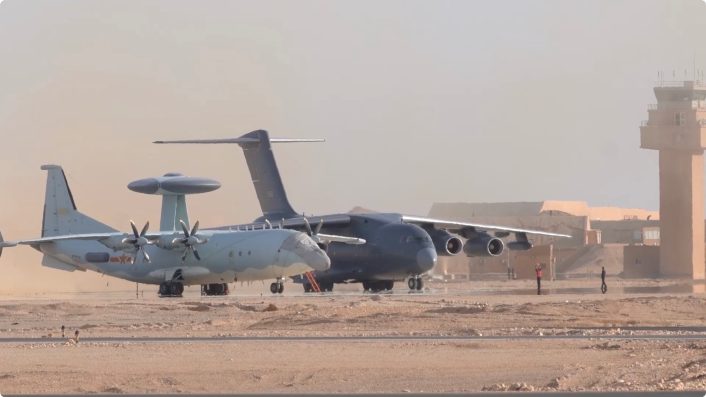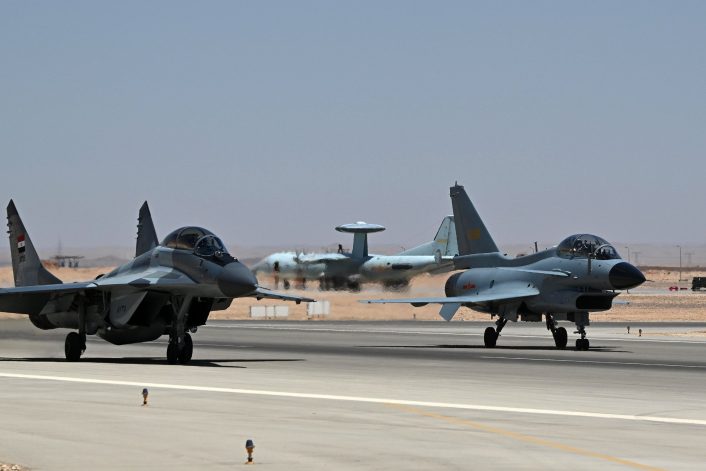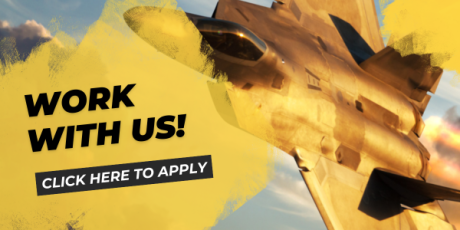The exercise comes amid reports of Egypt looking at potentially acquiring China’s J-10CE, but it also lays the foundation for future military exchanges and cooperation.
China and Egypt kicked off their first joint aerial drills, called “Eagles of Civilization 2025,” on Apr. 19, 2025, three days after the Chinese MND (Ministry of National Defense) announced the exercise. The drills will be held from mid April to early May 2025, according to the Chinese MND, at Wadi Abu Rish air base, Egypt.
“This is the first joint training between the Chinese and Egyptian militaries, which is of great significance to promoting pragmatic cooperation and enhancing mutual trust and friendship between the two militaries,” the MND added.
The Chinese aircraft involved, according to footage released by CCTV and details in a Global Times report, include J-10Cs, YU-20/YY-20A aerial refueling aircraft, at least one twin-seat J-10S and a KJ-500 AEW&C (Airborne Early Warning and Control) aircraft. The Egyptian Air Force (EAF) is employing its MiG-29M/M2 fighters.
The footage released on Apr. 19 shows various aircraft, including two YY-20, of which one without wing refueling pods, twin-seat MiG-29M2 and J-10S fighters; single-seat J-10Cs and a KJ-500. Chinese military aviation analyst Andreas Rupprecht identified one of the YY-20A tankers as the first airframe within the PLAAF’s 4th Transport Division.

Interestingly, a PLA Air Force Xi’an Y-20 strategic airlifter and a Shaanxi KJ-500 AEW&C aircraft have been spotted at Wadi Abu Rish Air Base in an Apr. 17, 2025, image from a Sentinel-2 satellite, shared on X by ‘BrianE6B’ ahead of the drills. Also, four to five Y-20s were spotted by open source flight trackers, during their flight from China to Egypt, between Apr. 13 and 15, with stopovers at Dubai in the UAE (United Arab Emirates).
China-Egypt joint air force exercise “Eagles of Civilization 2025” kicked off with the first training day on Saturday at an air base in Egypt. The Chinese side sent forces including fighter aircraft, early warning aircraft, tanker aircraft and helicopters to the drill. (Photos:… pic.twitter.com/jBj5m0iLoX
— Global Times (@globaltimesnews) April 20, 2025
Y-20 movement
As for the Y-20s tracked online, they carried equipment to support the exercise. The same flights also supported the deployment of the J-10s, as confirmed by one photo showing a J-10 in flight over Saudi Arabia.
📍 Chinese PLA AF 🇨🇳 Photo of J-10 fighters flying over Yanbu’s King Fahd Port 🇸🇦 a few days ago, port where US Navy ships dock to take supplies for the aircraft carrier USS Truman https://t.co/NGMevvK7q3 pic.twitter.com/m17gGO30d7
— MenchOsint (@MenchOsint) April 20, 2025
The Y-20s did not transmit their callsigns, but their ADS-B signals were identified with their ICAO (International Civil Aviation Organization) codes 7A4403, 7A4445, 7A425C, 7A426B, 7A444, 7A448F and 7A4403, as they travelled between China and Egypt. Some of the aircraft were then tracked by ‘AvScanNZ’ on X as they were returning to China. A Y-20, with the ADS-B code 7A445 and tail number 11256, was tracked heading back to China on Apr. 16, following a one-way journey on Apr. 15.
🇨🇳🇪🇬 From mid-April to early May, the PLA and Egyptian air forces will hold a joint exercise called “Eagle of Civilization 2025”. In preparation for it, at least four PLA Air Force Yun-20 military transport aircraft arrived in Egypt yesterday. pic.twitter.com/A4w10bXFsZ
— OSINT Expert (@OsintExperts) April 16, 2025
Chinese reports stressed on the rare display of the PLA Air Force’s long-range strategic airlift capability. The Y-20s have also been used to deliver the FK-3 air defense system (export variant of HQ-22 surface-to-air missile platform) to Serbia in Apr. 2022, when six of the aircraft travelled to Belgrade’s Nikola Tesla Airport.

Chinese goals
CCTV said that the drills “aim to enhance the technical and tactical levels” of both the PLAAF and EAF personnel, while being of “great significance to promoting pragmatic cooperation and enhancing mutual trust and friendship.” Talking about the air force drills following the Chinese MND announcement, Chinese military expert Wang Yunfei was quoted in a Global Times report saying that the exercises underscore the “good military relations, and the first joint exercise will further enhance mutual understanding and friendship.”
The GT report, following the start of the exercise, said the PLAAF “utilized a combined transport method of air transfer and air transport via multiple countries covering a range of nearly 6,000 kilometers, and all equipment and personnel arrived in Egypt by April 15.” The report further quoted Yunfei, who said the “long-distance maneuvering […] showed the PLA Air Force’s ability to operate far from home, and its adaptability to diverse environments.”
Interestingly, the Y-20 made its international debut at the Egypt International Air Show held from Aug. 27 to Sep. 4, 2024. The PLA Air Force had also sent seven J-10 fighter jets of the Bayi Aerobatic Team and, during the visit, the J-10s and the Y-20 flew over the Giza Pyramids, marking the nascent diplomatic and strategic relationship between the two countries.
It was also the first time the Bayi team visited an African country, in their farthest journey for a flight performance, demonstrating the PLAAF’s “confidence and openness,” mentioned an earlier statement from MND spokesperson Wu Qian.

Exercise components
Egypt’s Ahram Online said that the drills, over several days, would include “a mix of theoretical and practical training sessions, aiming to align combat strategies, with joint air sorties and mission planning exercises forming a core part of the program.” It would also “boost operational coordination and exchange expertise between the two air forces, while enhancing the readiness of pilots and crews for a range of combat scenarios.” Interestingly, neither CCTV nor Global Times has identified Wadi Abu Rish air base as the venue.
On the morning of April 19th Cairo time, the China Egypt “Civilization Eagle-2025” Air Force Joint Training welcomed its first training day at a certain base of the Egyptian Air Force.
开罗时间4月19日上午,中国埃及“文明之鹰-2025”空军联合训练在埃及空军某基地迎来首个训练日。 pic.twitter.com/iikfIHXDqP
— Walter (@WalterL87309879) April 20, 2025
“The two countries’ air forces share some similar training methods and tactics, and the latest joint exercise could pave the way for potential equipment cooperation in the future,” Wang said, noting that the Egyptian side will get an opportunity to closely observe the Chinese warplanes’ capabilities.
So we got some shots of 🇪🇬🇨🇳 “Eagles of Civilization 2025” and I don’t remember J10 Fighters ever being part of that Y20/KJ500 transit group 🤔
So were they were transported in those 6/7 Y20s ?
🥂 :) https://t.co/vXcbC2cC3t pic.twitter.com/q7W61029UD
— Húrin (@Hurin92) April 19, 2025
Global Times quoted Wang Ya’nan, chief editor of Beijing-based Aerospace Knowledge magazine, who said the Chinese aircraft deployed “are key representatives of the PLA Air Force’s main combat equipment.” The “YU-20 provides aerial refueling for the J-10C, significantly boosting range, while the KJ-500 can form a dense information system.”
Another expert, Zhang Xuefeng, also said the YU-20 tanker aircraft could be “compatible” with the Egyptian MiG-29s, “so theoretically they may practice aerial refueling.” The two sides could meanwhile also practice “basic maneuvers, coordinated combat, and tactical confrontation training,” while possibly visiting each other’s aircraft.”
🇪🇬🇨🇳 Egypt’s Wadi Abu Rish Air Base: Footage from the joint Chinese-Egyptian exercise “Eagle of Civilization – 2025”
The PLAAF is deploying a Yun-20U tanker, a Kunjing-500 AWACS aircraft, Jian-10C (b/n 62599) fighters from the 18th Air Brigade, and a Jian-10 (b/n 78082) fighter… pic.twitter.com/bvHvJ06EBb
— dana (@dana916) April 20, 2025
Egypt’ and China’ military cooperation
Egypt currently operates the Chinese-made K-8 trainer and has also shown interest in frontline fighter aircraft like the J-10. While reports swirled earlier this year about Cairo actually having received its first units of the light-weight single-engine delta-wing fighter, roughly in the same class as the F-16, Chinese MND spokesperson Wu Qian later officially denied such a transfer.
Another – and in my opinion mayor surprise 😮 – a YY-20A was spotted with the serial number 11550 in Egypt during the joint China-Egypt exercise „Civilization Eagle“
As such the first tanker within the 4th Transport Division.
(Image via @太湖军I名 from Weibo) pic.twitter.com/5nHgRrFDvY
— @Rupprecht_A (@RupprechtDeino) April 20, 2025
Wu said: “It is inconsistent with the facts. Total fake news.” The claims followed reports in 2023 about Cairo holding talks with Beijing over a potential purchase of the fighter. Prior to that, in 2021, China displayed the JF-17 Thunder and L-15 trainer at Egypt’s premier defense exhibition.
China’s domestically developed large transport aircraft, Y-20, showcased a solo flight performance at the Egypt International Airshow which kicked off on Tuesday. The airshow also featured static displays of J-10 fighter jets from China’s Bayi Aerobatic Team. pic.twitter.com/yNvinC7LHN
— China Perspective (@China_Fact) September 4, 2024
The Egyptian Air Force, meanwhile, operates a mix of Western and Russian aircraft, including Russian-made MiG-29M/M2, French-made Dassault Rafales and U.S.-made F-16C/D Block 40 and Block 52 jets. It is unlikely the Western platforms would participate in the drills. It would nevertheless be interesting to see how the two air forces and their diverse fleets’ logistical, communication and tactical protocols are harmonized.









